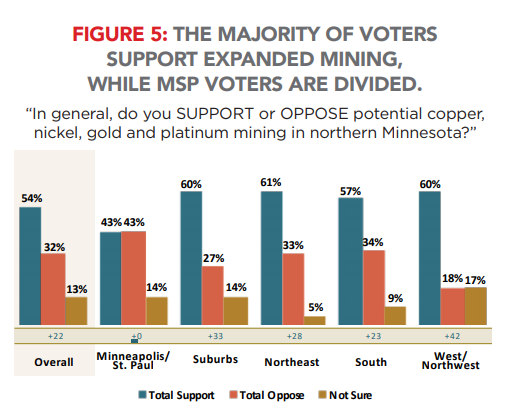Twin Metals Keeps On Winning, Despite Best Efforts of Urban DFL
Minnesota is home to the world’s largest undeveloped deposits of copper, nickel, and platinum group elements, and developing these mineral resources will be a massive boost to the economy of our state. While the PolyMet mine has received the necessary permits from the state, the proposed Twin Metals mine has been the ire of urban liberals and environmentalists who do not want to see the mine developed.
Fortunately, according to an article in MinnPost, the Trump administration has other ideas and has taken several concrete steps to support the project.
The Obama administration blocked new mineral leases for Twin Metals in 2016, citing concerns that acid mine drainage could harm the BWCA. But Obama’s administration was also studying the effect copper-nickel mining in Superior National Forest could have on the wilderness, which may have led to a 20-year moratorium on such mining.
Trump, a consistent advocate for mining and mineral extraction on public land, has flipped those decisions. In September, his administration ended the study and cancelled the application for a copper-nickel mining ban. It also worked to reverse the lease decision, arguing the original mineral agreement — which dates back to 1966 — didn’t give the government a choice over whether to grant Twin Metals a renewal. The government then reinstated Twin Metals’ leases, along with an application for a third renewal, which is the one now set to be granted. The leases had previously been renewed in 1989 and 2004.
After the announcement from the BLM on Thursday, Twin Metals spokesman David Ulrich issued a statement saying the company “looks forward to the timely and proper completion of the lease renewal process.” The company is owned by Chilean mining giant Antofagasta.
Norr, of Jobs for Minnesotans, said the BLM decision was “one of many important milestones that Twin Metals will work to achieve before entering the robust environmental review process required prior to any mining activity.” Twin Metals expects to process 20,000 tons of ore per day if it’s built. The company also says the underground mine would create 650 direct-full time jobs, plus another 1,300 spinoff jobs.
In response to the lease renewal plan, U.S. Rep. Betty McCollum, a DFLer from Minnesota’s 4th District, called the decision “blatantly political” and jabbed at Interior Secretary Ryan Zinke for the swarm of ethics investigations that prompted his resignation. (The BLM is part of Interior.)
McCollum will be the chairwoman of the powerful Appropriations Subcommittee on the Interior, Environment and Related Agencies when Democrats take House control in 2019. She has promised to investigate the Trump administration’s decisions related to Twin Metals and work to halt or slow the mine.
The lack of support for mining among urban liberals is consistent with the polling conducted by American Experiment. In our summer issue of Thinking Minnesota, we polled several questions about mining, and we found that urban voters are the least supportive of new mining projects.
In a way, this makes perfect sense. Urban voters, who are generally liberal, are the furthest removed from industries like mining and farming and therefore it is easy for them to forget that they are just as dependent upon the metals obtained through mining as anyone else. They’re also probably less likely to know someone who has worked in the mining industry, which is part of the reason why they do not understand why people in Northeastern Minnesota are so eager to see more opportunities in this industry.
While it is understandable why urban voters may be less supportive of the industry, it does not make their opposition to mining correct. The DNR’s approval of PolyMet’s proposed mine shows that mining companies can meet the strict standards established by the environmental protection agencies of Minnesota, and Twin Metals should get a fair shake at satisfying these requirements, as well.
Unfortunately, a lot of people want to make up their minds about the project before they examine any data on the potential environmental impacts of the mine, which isn’t very scientific, now is it?